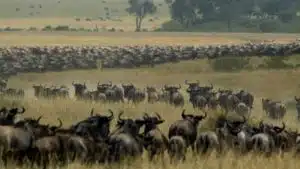What do you always find on grasslands? Many things, but large, hoofed animals grazing on the grass will be one of them in any truly alive place — buffalo, zebra, gazelles, wildebeest, etc. The grass and the animals evolved together, much like bees and flowering plants. They evolved to rely on each other. They developed characteristics that are adapted to each other.
So if you take away the grass, the hoofed animals die off. And if you take away the hoofed animals, the grassland turns into a desert.
The biologist Allan Savory has done more to wonder about this relationship than any other scientist. His answer and approach, called Holistic Management, was surprising to everyone involved. It didn’t really matter which animals were grazing. The key was HOW the animals were grazing. If the hoofed animals graze in a particular way, the grass grows and the deserts turn back into rich grassland. If they graze in any other way, or don’t graze at all, the land turns into a desert.
In a natural setting, two forces working together cause hoofed animals to graze the right way: predators and the need for fresh food. The presence of predators causes scattered grazing animals to bunch together in a big herd. They eat the grass and, of course, urinate and defecate. . After a couple of days of this, they are compelled by their noses to move to greener pastures. So the ground gets thoroughly and regularly “tilled” and “fertilized” and then left alone for a while. And the insects get busy and rhizomes under the soil get involved and suddenly grasses flourish. When the grass has grown tall, it lures the animals back into the area to do it all again. If the animals don’t come back, the tall grass rots and smothers any new grass trying to sprout.
Using grazing animals correctly, the grasses grow deeper roots over time, sequestering more carbon and holding more water, preventing runoff, preventing the loss of topsoil from wind and rain while building deeper topsoil, and protecting the plants and animals from dying off during droughts.
Here at Primal Derma we gather tallow from farmers that are trying to replicate this ancient relationship between cattle, the soil and land. And because these cows live on farms, even with acres and acres of pasture to roam, largely they are free from predators. And so heartbreakingly part of the relationship must be that there is a wolf as part of the relationship too. The farmers we are working with play that role of wolf and have made the ecologically wise but not always financially easy choice of going slower and not extracting every dollar they can as fast as they can.
You using Primal Derma is helping these kinds of farmers do the good work for the land and feeding the ancient relationship between the health of the land, the animals, and humans.
A road needs constant repair but a trail gets deeper and more useable by walking it. Thank you for walking this old trail with us.
If you need some more Primal Derma – let us know.
And let us know what you are thinking of these newsletters.

